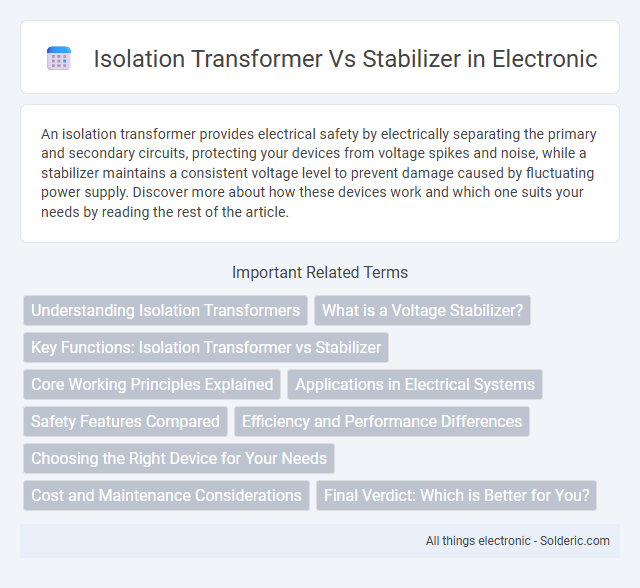An isolation transformer provides electrical safety by electrically separating the primary and secondary circuits, protecting your devices from voltage spikes and noise, while a stabilizer maintains a consistent voltage level to prevent damage caused by fluctuating power supply. Discover more about how these devices work and which one suits your needs by reading the rest of the article.
Comparison Table
| Feature | Isolation Transformer | Stabilizer |
|---|---|---|
| Primary Function | Electrical isolation and noise reduction | Voltage regulation and stabilization |
| Input Voltage Range | Fixed; isolates input from output | Wide; adjusts output voltage within range |
| Output Voltage | Same as input voltage (isolated) | Constant, regulated voltage |
| Protection Provided | Reduces electrical noise, prevents ground loops, safety isolation | Protects against voltage fluctuations, surges, drops |
| Application | Medical equipment, sensitive electronics, noise-sensitive devices | Household appliances, computers, industrial machinery |
| Working Mechanism | Magnetic induction between primary and secondary windings | Auto-transformer or servo motor based voltage adjustment |
| Cost | Moderate to high depending on power rating | Generally lower than isolation transformers |
| Efficiency | High; minimal power loss | Moderate; some loss due to voltage correction |
Understanding Isolation Transformers
Isolation transformers provide electrical separation between the input and output, enhancing safety by reducing the risk of electric shock and equipment damage from voltage spikes. They offer superior noise reduction and protect sensitive devices by isolating them from grounding issues and electrical noise present in the power supply. This isolation capability distinguishes them from stabilizers, which primarily regulate voltage levels without providing the same level of electrical separation.
What is a Voltage Stabilizer?
A voltage stabilizer is an electrical device designed to maintain a constant output voltage level despite fluctuations in the input voltage, protecting appliances from damage caused by voltage spikes or drops. Unlike isolation transformers, which primarily provide galvanic isolation and reduce electrical noise, voltage stabilizers regulate voltage by automatically adjusting the output to a predefined range. This regulation helps ensure the safe operation of sensitive electronic equipment in environments with unstable power supply.
Key Functions: Isolation Transformer vs Stabilizer
Isolation transformers provide electrical isolation between the input and output, designed to protect sensitive equipment from voltage spikes and electrical noise by transferring power through electromagnetic induction. Stabilizers regulate voltage levels by automatically adjusting the output voltage to maintain a stable and consistent power supply, protecting devices from voltage fluctuations and surges. Both play critical roles in power conditioning, with isolation transformers emphasizing electrical isolation and noise reduction, while stabilizers focus on voltage regulation and stability.
Core Working Principles Explained
An isolation transformer's core working principle involves galvanic isolation, where it transfers electrical power between two circuits via magnetic induction, effectively preventing direct current flow and protecting sensitive equipment from voltage spikes and electrical noise. In contrast, a stabilizer operates by regulating voltage fluctuations using servo mechanisms or electronic circuits to maintain a constant output voltage regardless of input variations. Your choice depends on whether you need electrical isolation for safety and noise reduction (isolation transformer) or voltage regulation for consistent power supply (stabilizer).
Applications in Electrical Systems
Isolation transformers are primarily used in sensitive electrical systems to provide electrical isolation, reduce noise, and protect against electric shocks by decoupling the input power from the output load. Stabilizers regulate voltage fluctuations, ensuring consistent power supply to devices like medical equipment, industrial machines, and home appliances, enhancing their performance and lifespan. Your choice depends on whether you need protection against voltage instability or isolation from electrical interference in critical applications.
Safety Features Compared
Isolation transformers provide enhanced electrical safety by completely separating the output from the input power source, effectively reducing the risk of electric shock and minimizing noise and voltage spikes. Stabilizers regulate voltage fluctuations, protecting devices from damage caused by unstable voltage but do not isolate the load from the mains supply, thus offering less protection against electrical faults. Safety benefits of isolation transformers make them ideal for sensitive electronic equipment, whereas stabilizers are better suited for voltage regulation in environments with frequent voltage variations.
Efficiency and Performance Differences
Isolation transformers provide superior efficiency by delivering clean power with minimal energy loss through galvanic isolation, reducing noise and voltage spikes. Voltage stabilizers regulate input voltage fluctuations by adjusting output voltage but may introduce slight power losses due to their internal circuitry. Isolation transformers excel in performance for sensitive equipment requiring consistent voltage quality, whereas stabilizers are more effective for maintaining steady voltage in variable supply conditions.
Choosing the Right Device for Your Needs
Choosing the right device depends on your specific electrical requirements and the sensitivity of your equipment. Isolation transformers provide electrical isolation and protect against voltage spikes and electrical noise, making them ideal for sensitive medical or laboratory devices. Voltage stabilizers regulate voltage fluctuations to prevent damage from overvoltage or undervoltage, which is essential for appliances operating in areas with unstable power supply.
Cost and Maintenance Considerations
Isolation transformers generally involve higher upfront costs due to their complex design and robust insulation materials, but they require minimal maintenance over time. Stabilizers tend to be more cost-effective initially, with simpler components that can lead to more frequent maintenance and potential replacement parts. Your choice should consider long-term expenses and the specific needs of your electrical system regarding reliability and service continuity.
Final Verdict: Which is Better for You?
Choosing between an isolation transformer and a stabilizer depends on your specific power quality needs and equipment sensitivity. Isolation transformers excel in providing electrical noise reduction and galvanic isolation, protecting sensitive electronics from voltage spikes and ensuring clean power supply. Stabilizers are more effective for regulating voltage fluctuations and maintaining steady output voltage, making them ideal for areas with unstable grid power.
isolation transformer vs stabilizer Infographic

 solderic.com
solderic.com